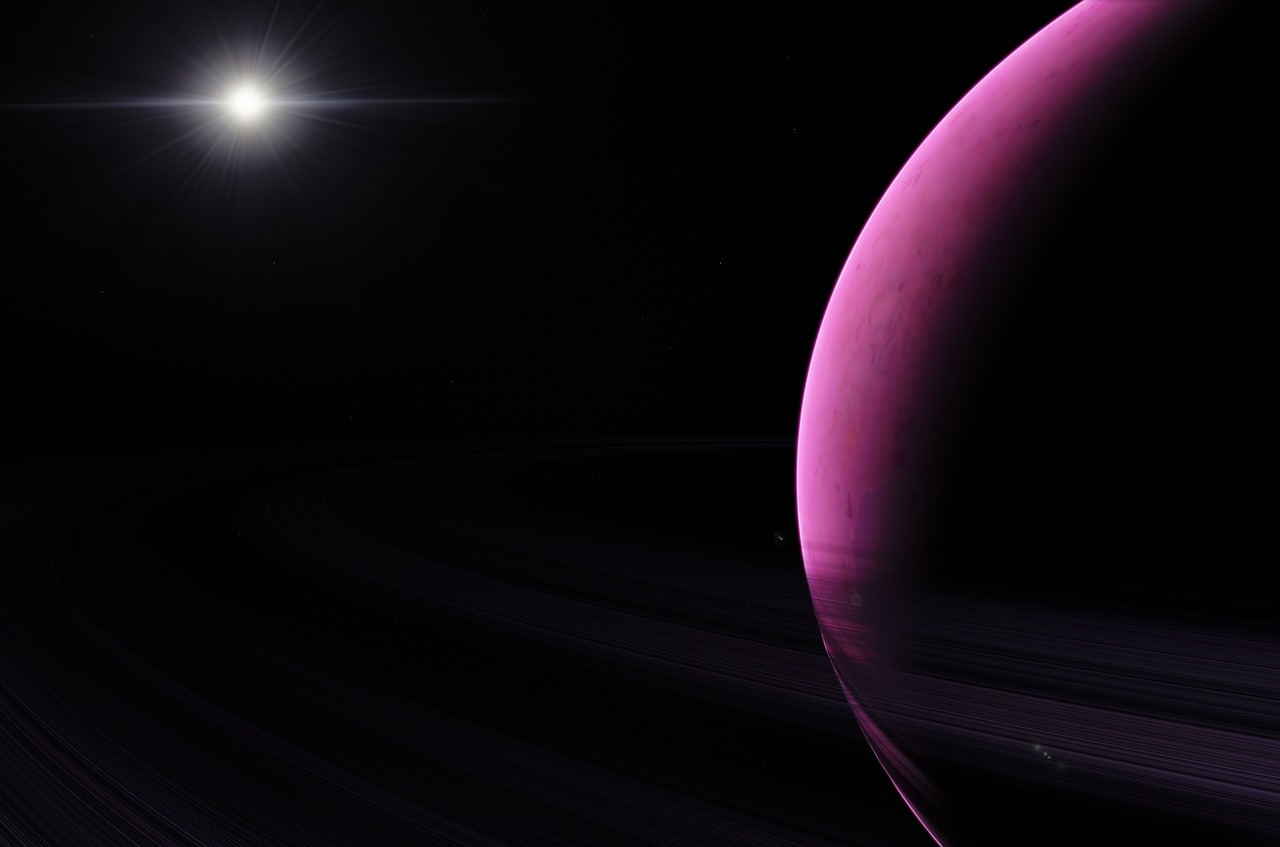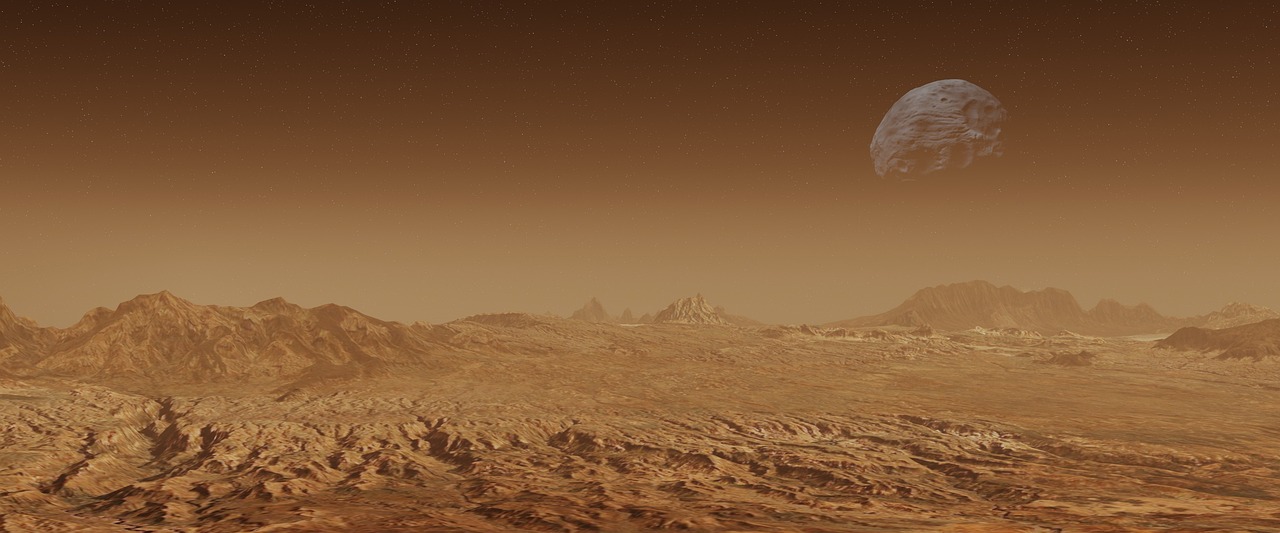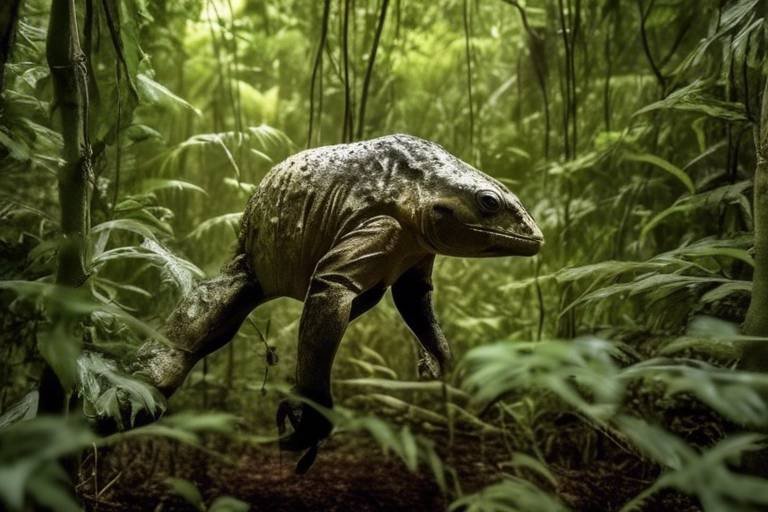Recent Discoveries in Astrobiology - Are We Alone?
The quest to uncover whether we are alone in the universe has never been more thrilling! Recent advancements in astrobiology have opened new doors to understanding the potential for life beyond Earth. Imagine standing on the brink of a cosmic revelation, where every new discovery could redefine our place in the vastness of space. From the search for distant exoplanets to the exploration of our own solar system, scientists are piecing together clues that might one day answer the age-old question: Are we alone?
Astrobiology, a field that intertwines biology, astronomy, and geology, is at the forefront of this exploration. It delves into the origins, evolution, and future of life in the universe. With each passing year, we are uncovering more about the conditions that could support life, not just on Earth, but on other planets and moons. This article will take you on a journey through the recent discoveries in astrobiology, highlighting the exciting possibilities that lie ahead.
As we embark on this journey, we must consider the implications of these discoveries. What does it mean for humanity if we find life elsewhere? How would it change our understanding of biology, evolution, and even our own existence? These questions fuel the passion of researchers and enthusiasts alike, as the search for extraterrestrial life continues to captivate our imaginations.
In the sections that follow, we will explore the search for exoplanets, the study of extremophiles, and the tantalizing evidence of life on Mars, as well as the icy moons of Europa and Enceladus. We will also delve into the importance of identifying biosignatures and technosignatures, the challenges that lie ahead, and the role of artificial intelligence in this groundbreaking field. So buckle up, because the universe is about to get a whole lot more interesting!
In recent years, astronomers have made significant strides in discovering exoplanets, some of which lie in the habitable zone of their stars, raising the possibility of life beyond Earth. With advanced telescopes and innovative detection methods, the hunt for these distant worlds has become more productive than ever. Astronomers now believe that there could be billions of exoplanets in our galaxy alone!
Studying extremophiles on Earth has provided insights into the resilience of life, suggesting that organisms could survive in harsh conditions on other planets or moons in our solar system. These remarkable life forms thrive in environments that were once thought to be uninhabitable, such as deep-sea hydrothermal vents and acidic hot springs. This resilience raises the exciting possibility that life could exist in similar extreme conditions elsewhere in the universe.
Mars missions have revealed evidence of past water and possibly microbial life, prompting scientists to investigate the planet's potential to host life forms, both past and present. The Red Planet is often seen as our best chance of finding evidence of extraterrestrial life within our solar system. With ongoing missions and future plans for sample return, the excitement surrounding Mars exploration is palpable.
The Curiosity Rover has provided crucial data about Martian soil and atmosphere, enhancing our understanding of the planet's ability to support life. Its findings have sparked debates and further research into the potential habitability of Mars. The rover's discoveries are like pieces of a cosmic puzzle, each one bringing us closer to understanding whether life ever existed on our neighboring planet.
Upcoming missions aim to return samples from Mars, which could offer definitive evidence of past or present life on the Red Planet. These missions are not just about collecting rocks; they represent humanity's bold step toward answering one of the most profound questions of our time. Will we find the signs of ancient microbial life? Only time will tell!
The icy moons of Jupiter and Saturn, Europa and Enceladus, are prime candidates for hosting life due to their subsurface oceans and potential hydrothermal activity. These moons are like hidden worlds, shrouded in ice but possibly teeming with life beneath their frozen surfaces. The exploration of these moons could unveil secrets that challenge our understanding of life's adaptability.
Identifying biosignatures—chemical indicators of life—on distant planets is crucial for understanding the existence of extraterrestrial organisms and their potential similarities to life on Earth. These biosignatures could be the key to unlocking the mysteries of life beyond our planet. Imagine the thrill of discovering a chemical signature that points to life on a distant exoplanet!
The search for technosignatures, or signs of advanced civilizations, is gaining momentum as scientists explore radio signals and other technological markers from space. This aspect of astrobiology raises fascinating questions about the nature of intelligence and technology in the universe. Are we alone, or are there other civilizations out there, perhaps watching us as we watch the stars?
Despite advancements, detecting biosignatures and technosignatures remains challenging due to the vastness of space and the limitations of current technology. The universe is a vast ocean, and finding specific signals among the noise can feel like searching for a needle in a haystack. However, scientists are continually innovating and refining their methods, pushing the boundaries of what is possible.
Artificial intelligence is revolutionizing the field of astrobiology by enhancing data analysis, improving the search for exoplanets, and aiding in the interpretation of complex biological data. AI algorithms can sift through vast amounts of data far more efficiently than humans, identifying patterns and signals that might otherwise go unnoticed. This technology is a game-changer in our quest to understand life in the universe.
As we explore the cosmos for signs of life, ethical considerations regarding the potential discovery of extraterrestrial organisms and their implications for humanity must be addressed thoughtfully. What responsibilities do we have if we encounter intelligent life? How should we approach the preservation of environments that may harbor life? These questions are crucial as we venture into the unknown.
- What is astrobiology? - Astrobiology is the study of the origins, evolution, and future of life in the universe, including the search for extraterrestrial life.
- Why is the search for exoplanets important? - Exoplanets provide insights into the potential for life beyond Earth and help us understand the conditions that support life.
- What are biosignatures? - Biosignatures are chemical indicators that suggest the presence of life, such as specific gases or organic molecules.
- What role does AI play in astrobiology? - AI enhances data analysis, improves the search for exoplanets, and aids in interpreting complex biological data.

The Search for Exoplanets
The quest to find exoplanets, or planets outside our solar system, has become one of the most exhilarating frontiers in modern astronomy. In recent years, astronomers have significantly advanced their techniques and technologies, leading to the discovery of thousands of these celestial bodies. Some of these exoplanets are located in the habitable zone of their respective stars, a region where conditions might be just right for life as we know it. Imagine a world where the air is breathable, water flows freely, and life flourishes—this is not just a dream but a scientific possibility.
One of the key methods used in the search for exoplanets is the transit method. This technique involves monitoring the brightness of stars over time. When a planet passes in front of a star, it causes a temporary dip in brightness. By analyzing these dips, scientists can infer the planet's size and orbit. This method has been pivotal in identifying many of the exoplanets cataloged by missions like Kepler and TESS (Transiting Exoplanet Survey Satellite).
Additionally, the radial velocity method measures the wobble of stars caused by the gravitational pull of orbiting planets. This subtle movement can reveal the presence of planets, even those that are not directly observable. As technology advances, astronomers are developing even more sophisticated instruments to detect smaller and more distant exoplanets, expanding our understanding of the universe.
| Exoplanet Discovery Methods | Description |
|---|---|
| Transit Method | Detects planets by observing dips in starlight as they pass in front of a star. |
| Radial Velocity Method | Measures the star's wobble due to gravitational pull from orbiting planets. |
| Direct Imaging | Involves capturing images of exoplanets by blocking out starlight. |
| Gravitational Microlensing | Uses the gravitational field of a star to magnify the light of a more distant star, revealing planets. |
As we delve deeper into the cosmos, the concept of a Goldilocks Zone becomes increasingly relevant. This zone is not too hot and not too cold, allowing for the presence of liquid water—an essential ingredient for life. Scientists have identified numerous exoplanets within this zone, igniting discussions about their potential to harbor life. It's like searching for a needle in a haystack, but every discovery brings us one step closer to answering the age-old question: Are we alone in the universe?
Moreover, the sheer diversity of exoplanets discovered to date is astounding. From gas giants larger than Jupiter to rocky planets similar to Earth, the variety is reminiscent of a cosmic buffet. Some exoplanets even orbit multiple stars, creating unique day-night cycles and climates. Each new finding adds a layer of complexity to our understanding of planetary formation and the potential for life.
In conclusion, the search for exoplanets is not just about finding new worlds; it's about exploring the very nature of existence. With every new discovery, we inch closer to understanding our place in the universe and the possibility that we may not be alone. As technology continues to evolve, who knows what other secrets the cosmos has in store for us?

Life in Extreme Environments
When we think about life, we often picture lush forests, vibrant oceans, and sprawling meadows. But what if I told you that life can thrive in the most extreme environments imaginable? From scorching hot springs to the freezing depths of the Antarctic, extremophiles—organisms that can survive in harsh conditions—are rewriting the rules of biology. These resilient life forms are not just a curiosity; they offer profound insights into the possibility of life beyond Earth.
Extremophiles have been discovered in some of the most inhospitable places on our planet. For instance, the Great Salt Lake in Utah is home to halophiles, organisms that flourish in high-salinity environments. Similarly, thermophiles thrive in the boiling waters of geysers like those found in Yellowstone National Park. These creatures have adapted to conditions that would be lethal to most life forms, showcasing nature's incredible ability to adapt and survive.
But why should we care about these hardy organisms? The study of extremophiles opens up exciting possibilities when we consider other planets and moons in our solar system. For example, Mars, with its harsh climate and thin atmosphere, might seem uninhabitable at first glance. However, the discovery of ancient riverbeds and minerals that form in water suggests that it once had conditions suitable for life. If life can exist in the extreme environments of Earth, perhaps it could also survive on Mars, or even in the icy ocean of Europa, one of Jupiter's moons.
To illustrate this point, let's take a look at some key extremophiles and their environments:
| Extremophile | Environment | Key Adaptations |
|---|---|---|
| Halophiles | High-salinity environments (e.g., salt flats) | Produce proteins that stabilize their cells in salty conditions |
| Thermophiles | High-temperature environments (e.g., hot springs) | Have heat-stable enzymes that function at extreme temperatures |
| Psychrophiles | Cold environments (e.g., Antarctica) | Produce antifreeze proteins to survive freezing temperatures |
What’s even more intriguing is the idea that these extremophiles might not just be limited to Earth. Scientists believe that if life can survive in such harsh conditions here, it could potentially exist in similar environments on other celestial bodies. For instance, the subsurface ocean of Europa is thought to harbor conditions that could support life, thanks to its warmth generated by tidal heating. Similarly, Enceladus, another moon of Saturn, has geysers that spew water vapor into space, hinting at a hidden ocean beneath its icy crust.
In summary, the study of life in extreme environments not only broadens our understanding of biology but also fuels the quest for extraterrestrial life. The resilience of extremophiles could very well be a blueprint for finding life beyond our planet. As we continue to explore the cosmos, these tiny, tenacious organisms remind us that life is exceptionally adaptable, and perhaps, we are not as alone in the universe as we once thought.
- What are extremophiles? Extremophiles are organisms that thrive in extreme environmental conditions, such as high salinity, extreme temperatures, or high pressure.
- Why are extremophiles important for astrobiology? They provide insights into the potential for life in harsh environments on other planets and moons, suggesting that life could exist elsewhere in the universe.
- Can life exist on Mars? Evidence suggests that Mars may have once had conditions suitable for life, and ongoing research aims to uncover more about its potential to host life.
- What is Europa, and why is it significant? Europa is a moon of Jupiter believed to have a subsurface ocean, making it a prime candidate for the search for extraterrestrial life.

Mars Exploration
The quest to uncover the mysteries of Mars has captivated humanity for decades. With its striking red surface and tantalizing hints of water, Mars stands as a prime candidate in our search for extraterrestrial life. Recent missions have provided a treasure trove of data, revealing that this once-wet planet may have harbored conditions suitable for life. Isn't it fascinating to think that we might be standing on the brink of discovering whether we are truly alone in the universe?
NASA's Mars missions, particularly the Curiosity Rover and the more recent Perseverance Rover, have been instrumental in piecing together Mars' ancient climate and geological history. Curiosity, which landed in 2012, has been tirelessly analyzing Martian soil and rocks, finding evidence of ancient riverbeds and lakes. This data suggests that liquid water once flowed on the surface, creating an environment that could have supported microbial life. Imagine a world where tiny organisms thrived, perhaps even evolving in ways we can't yet comprehend!
In addition to geological findings, the search for microbial life has intensified. The question on everyone’s mind is: did life ever exist on Mars? To address this, scientists are examining the planet's atmosphere for methane, a gas that, on Earth, is primarily produced by living organisms. The presence of methane could indicate biological processes, although it can also arise from geological activity. This duality makes the exploration all the more thrilling, as every discovery could lead us closer to understanding Mars' biological potential.
Curiosity's findings have been nothing short of groundbreaking. One of its most significant discoveries is the identification of organic molecules in Martian soil. These molecules, while not definitive proof of life, are the building blocks of life as we know it. They raise the tantalizing possibility that, under the right conditions, life could emerge. Moreover, Curiosity has analyzed the Martian atmosphere, revealing fluctuations in methane levels that hint at seasonal changes in potential biological activity. This kind of data is like a breadcrumb trail leading us to the ultimate question: could there have been life on Mars?
Looking ahead, upcoming missions are set to propel our understanding of Mars even further. The Sample Return Mission, planned for the next few years, aims to collect and return soil samples to Earth. This mission is crucial because it could provide definitive evidence of past or present life on the Red Planet. Imagine holding in your hands a piece of another world that might have once teemed with life! The excitement is palpable as scientists prepare for this monumental task, which could reshape our understanding of life in the universe.
In conclusion, Mars exploration is not just about discovering a new planet; it's about understanding our own origins and the potential for life beyond Earth. With every rover mission, we inch closer to answering the age-old question of whether we are alone in the cosmos. The journey is thrilling, filled with unexpected twists, and the possibilities are as vast as the Martian landscape itself.
- What evidence suggests that Mars could have supported life?
Evidence includes the discovery of ancient riverbeds, lakes, and organic molecules in Martian soil. - How does the Curiosity Rover contribute to our understanding of Mars?
Curiosity analyzes soil and atmospheric samples, providing data on Mars' climate and potential for life. - What are the goals of future Mars missions?
Future missions aim to return samples to Earth to search for definitive evidence of life. - Why is methane important in the search for life on Mars?
Methane can indicate biological processes, but it can also be produced by geological activity.

Curiosity Rover Findings
The Curiosity Rover, a marvel of modern engineering, has been roaming the Martian landscape since its landing in 2012. Its mission? To uncover the secrets of Mars, particularly its potential to support life. One of the most exciting findings from Curiosity is the discovery of ancient riverbeds and minerals that form in the presence of water. This evidence suggests that liquid water once flowed on the Martian surface, creating an environment that could have been hospitable to life millions of years ago.
Curiosity has also analyzed the Martian soil, revealing a complex mix of chemicals that hint at the planet's geological history. For instance, the presence of clay minerals indicates that water was not just a fleeting visitor but rather a significant player in shaping the Martian landscape. These findings have led scientists to hypothesize about the potential for microbial life to have existed in these ancient water bodies.
Moreover, the rover has been equipped with a suite of scientific instruments designed to detect organic molecules—essential building blocks of life. In its quest, Curiosity has detected organic compounds in the Martian soil, raising the tantalizing possibility that life may have existed on Mars at some point in its history. These organic molecules, while not definitive proof of life, are crucial clues that scientists are eager to investigate further.
To summarize the key findings from the Curiosity Rover, let's take a look at the following table:
| Finding | Description |
|---|---|
| Ancient Riverbeds | Evidence of past water flow, indicating a potentially habitable environment. |
| Clay Minerals | Indicates prolonged interaction with water, suggesting a stable environment for life. |
| Organic Compounds | Presence of carbon-based molecules, hinting at the possibility of past life. |
As the Curiosity Rover continues its journey, it sends back invaluable data that not only enhances our understanding of Mars but also ignites our imagination about the potential for life beyond Earth. Each discovery is a stepping stone toward answering the profound question: Are we alone in the universe? With every rock sample and atmospheric reading, we inch closer to unraveling the mysteries of our neighboring planet.
In the coming years, as new missions are planned to return samples from Mars, the findings from Curiosity will serve as a critical foundation for future explorations. Imagine the thrill of holding Martian soil in our hands, examining it for signs of life that may have existed long before humanity looked up at the stars. The journey of discovery is just beginning, and the Curiosity Rover is at the forefront of this exciting quest.
- What is the Curiosity Rover? The Curiosity Rover is a car-sized rover designed to explore Mars and gather data about its geology and climate.
- What has Curiosity discovered on Mars? Curiosity has discovered evidence of ancient riverbeds, clay minerals, and organic compounds, suggesting Mars may have once supported life.
- How does Curiosity analyze Martian soil? The rover uses a variety of scientific instruments, including a drill and spectrometers, to analyze soil samples and detect chemical compositions.
- What are the implications of Curiosity's findings? The findings suggest that Mars had conditions suitable for life in the past, raising questions about the potential for current or past microbial life.

Future Missions to Mars
The excitement surrounding future missions to Mars is palpable, as scientists and space enthusiasts alike eagerly anticipate what these endeavors might reveal about the Red Planet. With each successful mission, we inch closer to answering the age-old question: Is there life beyond Earth? Upcoming missions are not just about exploration; they are about unraveling the mysteries that Mars holds beneath its dusty surface.
One of the most anticipated missions is NASA's Sample Return Mission, which aims to collect soil and rock samples from Mars and bring them back to Earth for detailed analysis. Imagine the thrill of holding a piece of Mars in our hands! This mission is a collaboration between NASA and the European Space Agency (ESA) and is set to launch in the late 2020s. The samples collected could provide definitive evidence of past or present life, offering insights that are currently beyond our reach.
Additionally, the Perseverance Rover, which landed on Mars in February 2021, continues to play a crucial role in this quest. It is equipped with advanced scientific instruments designed to search for biosignatures in the Martian soil. The rover's mission will last at least one Martian year, which is about 687 Earth days, but it has the potential to operate much longer. As it explores the Jezero Crater, where ancient river deltas once existed, scientists are hopeful that it will uncover signs of microbial life that may have thrived billions of years ago.
Furthermore, private companies like SpaceX are also gearing up for their own Mars missions. Elon Musk's vision of sending humans to Mars is not just a dream; it's a plan that could become a reality within the next decade. The Starship spacecraft is being developed with the goal of carrying humans to Mars and establishing a sustainable presence there. This ambitious mission raises intriguing possibilities about human colonization and the ethical implications of altering another planet's ecosystem.
To summarize, future missions to Mars are set to revolutionize our understanding of the planet and its potential to harbor life. Here’s a quick look at some of the key missions planned:
| Mission | Launch Date | Objective |
|---|---|---|
| Nasa's Sample Return Mission | Late 2020s | Collect and return Martian soil samples |
| Perseverance Rover | 2021 | Search for biosignatures |
| SpaceX Mars Mission | 2020s | Establish human presence on Mars |
As we look forward to these missions, the potential for groundbreaking discoveries looms large. What will we find? Will we uncover evidence of ancient life, or perhaps even current microbial organisms? The thrill of the unknown drives our exploration, and with each mission, we get one step closer to understanding our place in the universe. The journey to Mars is not just a scientific endeavor; it is a testament to human curiosity and the relentless pursuit of knowledge.
Q: What is the main goal of future Mars missions?
A: The primary goal is to search for evidence of past or present life on Mars and to collect samples for analysis on Earth.
Q: How do scientists plan to return samples from Mars?
A: NASA's Sample Return Mission will involve collecting samples with the Perseverance Rover and launching them back to Earth using a specially designed spacecraft.
Q: When can we expect humans to land on Mars?
A: While timelines vary, SpaceX aims to send humans to Mars in the mid-2020s, with plans for establishing a sustainable presence in the following years.
Q: What challenges do future Mars missions face?
A: Challenges include the harsh Martian environment, the complexity of landing and launching from Mars, and ensuring the safety of astronauts during long-duration space travel.

Europa and Enceladus
When we gaze at the icy moons of Jupiter and Saturn, Europa and Enceladus, we can't help but feel a sense of wonder. These celestial bodies are not just beautiful; they are tantalizing clues in our quest to understand life's potential beyond Earth. Both moons harbor vast subsurface oceans beneath their icy crusts, making them prime candidates for hosting life. Imagine an alien ecosystem thriving in a hidden ocean, far removed from the harsh conditions of space! This thought alone ignites our imagination and propels scientific inquiry.
Europa, with its smooth, cracked surface, is believed to have a salty ocean beneath that could be in contact with its rocky mantle. This interaction could create the necessary chemical reactions conducive to life. Scientists are particularly intrigued by the potential for hydrothermal vents on the ocean floor, similar to those found on Earth. These vents could provide the energy and nutrients necessary for life to flourish in complete darkness, akin to the thriving ecosystems we find in the depths of our own oceans.
On the other hand, Enceladus has captured the attention of researchers with its spectacular geysers that eject plumes of water vapor and ice particles into space. These geysers suggest that there is indeed a subsurface ocean beneath its icy shell. The discovery of organic molecules in the plumes has further fueled speculation about the moon's habitability. If life exists in these hidden oceans, it might be vastly different from what we know, adapted to extreme conditions and relying on different biochemical pathways.
| Moon | Key Features | Potential for Life |
|---|---|---|
| Europa | Subsurface ocean, smooth icy surface, potential hydrothermal activity | High - chemical reactions possible with rocky mantle |
| Enceladus | Geysers, organic molecules in plumes, subsurface ocean | High - organic compounds and water present |
The exploration of these moons is not just about searching for extraterrestrial life; it’s about understanding the very nature of life itself. What does it mean to be alive? How resilient can life be? As we prepare for future missions, such as NASA's Europa Clipper and the potential for a lander on Enceladus, we are on the brink of potentially groundbreaking discoveries. These missions aim to analyze the moons’ surfaces and subsurface oceans, looking for signs of habitability and, perhaps, even life.
In conclusion, Europa and Enceladus stand as beacons of hope in our quest to answer the age-old question: Are we alone in the universe? The more we learn about these icy worlds, the more we realize that life could exist in forms we have yet to imagine. As we continue our exploration, we must remain open-minded and ready to redefine our understanding of life itself.
- What makes Europa and Enceladus potential candidates for life?
Both moons have subsurface oceans beneath their icy crusts, and evidence suggests they may have the necessary chemical ingredients and energy sources for life.
- What are hydrothermal vents, and why are they important?
Hydrothermal vents are openings in the ocean floor that release heated water rich in minerals. They can provide energy and nutrients for life in environments devoid of sunlight.
- What missions are planned to explore these moons?
NASA's Europa Clipper mission will study Europa's ice shell and subsurface ocean, while future missions may target Enceladus to analyze its geysers and search for biosignatures.

Astrobiological Signatures
Identifying biosignatures—the chemical indicators of life—on distant planets is a crucial step in our quest to understand the existence of extraterrestrial organisms. Imagine peering into the vastness of space, searching for the faint echoes of life that might exist billions of miles away. Just as a detective looks for clues at a crime scene, scientists are meticulously examining the atmospheres of exoplanets for signs that life, as we know it, might be thriving in places we have never even visited.
These biosignatures can come in various forms, such as specific gases that are typically produced by living organisms. For example, the presence of oxygen and methane together in a planet's atmosphere could indicate biological activity, as these gases tend to react with each other and would not coexist in significant quantities without a continuous source. Other potential biosignatures include:
- Ozone (O3) - A byproduct of oxygen production, often linked to photosynthetic life.
- Chloromethane - A compound that could be produced by microbial life.
- Phosphine - A gas that, on Earth, is primarily created by anaerobic organisms.
However, identifying these signatures is not without its challenges. The vastness of space, combined with the limitations of our current technology, makes it incredibly difficult to isolate these faint signals from the background noise of the universe. Moreover, the interpretation of these signatures can be complicated by the presence of abiotic processes—natural phenomena that could produce similar chemical signatures without any biological involvement. Thus, scientists must tread carefully, ensuring that they do not jump to conclusions based on misleading data.
In addition to biosignatures, the search for technosignatures—indicators of advanced civilizations—has gained traction in recent years. This includes the detection of artificial signals, such as radio waves or laser emissions, that could suggest the presence of intelligent life. The ongoing efforts to scan the cosmos for these signals are reminiscent of a cosmic game of hide and seek, where we are both the seekers and the players. The potential discovery of technosignatures could fundamentally alter our understanding of our place in the universe and raise profound questions about the nature of life itself.
As we delve deeper into the universe, the quest for astrobiological signatures not only fuels our curiosity but also challenges our understanding of life. What if we find that life exists in forms we cannot even imagine? This tantalizing possibility keeps scientists and dreamers alike gazing at the stars, pondering the mysteries that lie beyond our home planet.
- What are biosignatures? Biosignatures are chemical indicators that suggest the presence of life, such as specific gases in a planet's atmosphere.
- How do scientists detect biosignatures? Scientists use telescopes and spectrometers to analyze the light from distant planets, looking for specific chemical signatures that might indicate life.
- What are technosignatures? Technosignatures are signs of advanced civilizations, such as artificial radio signals or other technological markers.
- Why is the search for astrobiological signatures important? Discovering biosignatures or technosignatures could revolutionize our understanding of life in the universe and our place within it.

Technosignatures
In the quest to unravel the mysteries of the universe, the search for has emerged as a captivating frontier in astrobiology. But what exactly are technosignatures? Simply put, they are indicators of advanced civilizations, often manifesting as artificial signals or structures that could suggest the presence of intelligent life beyond our planet. Imagine tuning into a cosmic radio station, hoping to catch a glimpse of an extraterrestrial broadcast or perhaps the glow of a distant megastructure built by an alien race. Sounds thrilling, right?
As scientists delve deeper into the cosmos, they employ various methods to detect these elusive technosignatures. One of the primary techniques involves analyzing radio waves emitted from distant stars. The idea is that if an advanced civilization exists, they might be using technology that generates detectable signals. Recent projects like the Breakthrough Listen Initiative have dedicated vast resources to scanning the skies for such signals, making it one of the most ambitious searches for extraterrestrial intelligence (SETI) in history.
Moreover, the search for technosignatures isn't limited to radio waves. Researchers are also investigating other potential indicators, including:
- Laser emissions: Powerful beams of light that could be used for communication or propulsion.
- Infrared signatures: Heat emissions from large-scale structures that might indicate energy consumption by an advanced civilization.
- Artificial chemical markers: Unusual atmospheric compositions on exoplanets that might suggest industrial activity.
Despite the excitement surrounding technosignatures, the search is fraught with challenges. The sheer vastness of space means that any signals we receive could be incredibly faint, making detection a daunting task. Additionally, distinguishing between natural cosmic phenomena and artificial signals requires sophisticated technology and analysis methods. For instance, the SETI Institute uses advanced algorithms and machine learning techniques to sift through enormous amounts of data, filtering out noise to identify potential signals worth investigating.
As we continue to refine our search methods, the implications of discovering a technosignature could be profound. It would not only confirm that we are not alone in the universe but also challenge our understanding of life, intelligence, and our place in the cosmos. Could we learn from these civilizations? Would they be friendly, or would they pose a threat? These questions linger in the minds of scientists and enthusiasts alike.
In summary, the hunt for technosignatures is a thrilling endeavor that combines science, technology, and a dash of imagination. As we push the boundaries of our understanding and capabilities, the dream of discovering signs of intelligent life beyond Earth becomes more tangible, igniting curiosity and wonder about what lies beyond our blue planet.
- What are technosignatures? Technosignatures are signs of advanced civilizations, often detected through artificial signals or structures.
- How do scientists search for technosignatures? Researchers analyze radio waves, laser emissions, infrared signatures, and artificial chemical markers to detect potential indicators of intelligent life.
- What challenges do scientists face in detecting technosignatures? The vastness of space, faint signals, and distinguishing between natural phenomena and artificial signals pose significant challenges.
- What would it mean if we discovered a technosignature? It would suggest that we are not alone in the universe and could lead to profound implications for our understanding of life and intelligence.

Challenges in Detection
The quest to uncover the secrets of extraterrestrial life is thrilling, yet it is fraught with challenges that can make even the most seasoned scientists scratch their heads in bewilderment. One of the primary hurdles is the **vastness of space**. Imagine trying to find a needle in a haystack, but the haystack is the size of the universe! With billions of stars and potentially even more planets, the sheer scale makes it incredibly difficult to pinpoint where to look for signs of life.
Another significant challenge lies in the **limitations of current technology**. While telescopes and satellites have advanced tremendously, they still struggle to detect faint signals or biosignatures from distant worlds. For instance, the light from a planet that might harbor life can be obscured by the brightness of its star, making it nearly impossible to analyze its atmosphere for signs of life. This is why researchers are constantly pushing the boundaries of technology, developing new instruments capable of more precise measurements.
Moreover, the **diversity of life** itself adds to the complexity. Life on Earth is incredibly varied, thriving in environments that range from the deepest ocean trenches to the hottest deserts. This raises a critical question: what if extraterrestrial life forms are entirely different from what we know? They could possess biosignatures that we have yet to identify. For example, while we search for oxygen or methane as indicators of life, there might be organisms that utilize entirely different biochemical processes. This uncertainty means scientists must broaden their definitions and methods of detection.
To illustrate these challenges, consider the following table that summarizes the key obstacles in detecting extraterrestrial life:
| Challenge | Description |
|---|---|
| Vastness of Space | The enormous distances between stars and planets make detection difficult. |
| Technological Limitations | Current instruments may not be sensitive enough to detect faint signals. |
| Diversity of Life | Extraterrestrial organisms may have unfamiliar biosignatures. |
| Environmental Factors | Conditions on distant planets may hinder the formation of recognizable life. |
Lastly, environmental factors on these distant worlds can complicate our search. For instance, planets may have extreme temperatures, high radiation levels, or toxic atmospheres that could prevent life from developing or persisting. Each of these challenges requires innovative solutions and collaborative efforts across various scientific disciplines to enhance our understanding and improve our detection methods.
In conclusion, while the challenges in detecting extraterrestrial life are substantial, they also fuel the excitement and curiosity that drive the field of astrobiology. As technology advances and our understanding deepens, we may yet find the answers to some of humanity's most profound questions: Are we alone in the universe? The journey to uncover these mysteries continues, and with it, the hope of making groundbreaking discoveries.
- What are biosignatures? Biosignatures are chemical indicators that suggest the presence of life, such as specific gases in a planet's atmosphere.
- Why is the search for extraterrestrial life important? Discovering extraterrestrial life could fundamentally change our understanding of biology, evolution, and our place in the universe.
- How do scientists search for life on other planets? Scientists use telescopes to analyze the atmospheres of exoplanets and search for specific chemical signatures that indicate life.

The Role of Artificial Intelligence
Artificial Intelligence (AI) is no longer just a futuristic concept; it's a powerful tool that's actively reshaping the field of astrobiology. Imagine having a super-smart assistant that can sift through mountains of data faster than you can say "extraterrestrial life." That's what AI does! By leveraging advanced algorithms and machine learning techniques, researchers can analyze vast datasets from telescopes and space missions, uncovering patterns and anomalies that might otherwise go unnoticed. This capability is particularly crucial when searching for signs of life beyond our planet, as the data we gather is often complex and voluminous.
One of the most exciting applications of AI in astrobiology is in the search for exoplanets. AI systems can analyze light curves—graphs that show the brightness of stars over time—to detect the subtle dips in light that indicate a planet passing in front of a star. This method, known as the transit method, has been enhanced significantly by AI, allowing scientists to identify potential exoplanets in the habitable zones of their stars more efficiently. For instance, NASA's Kepler Space Telescope has utilized AI algorithms to sift through its data, leading to the discovery of thousands of new exoplanets.
Moreover, AI is not just limited to identifying exoplanets; it also plays a vital role in data interpretation. With the immense amount of information collected from missions to Mars or the icy moons of Europa and Enceladus, AI algorithms help researchers make sense of complex biological data. For example, AI can assist in identifying biosignatures—chemical indicators of life—by analyzing spectral data from distant planets. This means that AI can help us understand whether the elements we find on these planets are indicative of life as we know it, or if they point to entirely new forms of life.
However, the role of AI in astrobiology isn't without its challenges. One major concern is the accuracy of AI predictions. While AI can process data at incredible speeds, it is only as good as the data it is trained on. If the training data is biased or incomplete, the results can lead to incorrect conclusions. Therefore, ongoing collaboration between AI experts and astrobiologists is essential to ensure that the technologies developed are reliable and can truly contribute to our understanding of life beyond Earth.
Additionally, as we integrate AI into our research, ethical considerations arise. Questions about the implications of AI-driven discoveries and the potential for misinterpretation of data must be addressed. Will we be prepared to handle the consequences if we discover signs of life that challenge our understanding of biology? It's crucial that we approach these advancements with a sense of responsibility, ensuring that we maintain a balance between exploration and ethical considerations.
In summary, AI is revolutionizing astrobiology by enhancing our ability to search for and analyze data related to extraterrestrial life. Its potential to uncover new worlds and identify biosignatures is exciting, but it also requires careful consideration of the ethical implications and the importance of accurate data interpretation. As we stand on the brink of potentially groundbreaking discoveries, the collaboration between AI and astrobiology could very well change our understanding of our place in the universe.
- How does AI help in the search for exoplanets?
AI algorithms analyze light curves to detect potential exoplanets by identifying the small changes in brightness caused by planets passing in front of their stars. - What are biosignatures?
Biosignatures are chemical indicators that suggest the presence of life, often identified through spectral data analysis. - Are there ethical concerns with using AI in astrobiology?
Yes, ethical considerations include the accuracy of AI predictions and the implications of discovering extraterrestrial life. - What role does collaboration play in AI and astrobiology?
Collaboration between AI experts and astrobiologists is essential to ensure reliable technologies and accurate data interpretation.

Ethical Considerations
As we venture deeper into the cosmos, the prospect of discovering extraterrestrial life raises profound ethical questions that we must grapple with. What would it mean for humanity if we were to find living organisms beyond Earth? Would we have the right to study them, or even to interfere with their ecosystems? These questions are not merely academic; they touch on our very understanding of life and our responsibilities as stewards of our own planet.
One of the primary ethical dilemmas revolves around the potential impact on discovered extraterrestrial life forms. If we were to encounter microbial life on Mars or in the oceans of Europa, would our exploration and experimentation endanger their existence? The principle of non-interference comes into play here. Just as we strive to protect endangered species on Earth, should we not extend this principle to life forms we might discover elsewhere?
Moreover, the implications of finding intelligent extraterrestrial civilizations are even more complex. The potential for technological exchange could lead to significant advancements for humanity, but it also raises concerns about the ethical treatment of these civilizations. Would we be prepared to engage with them as equals, or would we risk imposing our values and systems upon them? The history of human exploration is fraught with examples of exploitation and colonization; we must ensure that we do not repeat these mistakes on a cosmic scale.
Additionally, we must consider the ethical ramifications of our search for life. The use of advanced technologies, such as artificial intelligence, to analyze data from distant planets could lead to unintended consequences. For instance, if we were to inadvertently transmit signals that could be detected by extraterrestrial civilizations, we might expose ourselves to risks we cannot yet comprehend. This potential for miscommunication or misunderstanding could have dire consequences.
To navigate these complexities, it is essential to establish a framework of ethical guidelines for astrobiology. This framework should encompass:
- Respect for all forms of life, regardless of their origin.
- Commitment to non-interference in extraterrestrial ecosystems.
- Transparency in communication and engagement with potential extraterrestrial intelligences.
- Consideration of the long-term consequences of our actions in space exploration.
In conclusion, as we stand on the brink of potentially groundbreaking discoveries, we must approach the search for extraterrestrial life with a sense of responsibility and caution. The ethical considerations surrounding this endeavor are as vast as the universe itself, and it is our duty to ensure that we tread carefully as we seek to understand our place in the cosmos.
Q1: What are the main ethical concerns regarding extraterrestrial life?
A1: The main ethical concerns include the potential impact on discovered life forms, the treatment of intelligent civilizations, and the risks associated with our own communications and actions in space.
Q2: How can we ensure that we do not harm extraterrestrial ecosystems?
A2: By adhering to principles of non-interference and establishing ethical guidelines for exploration, we can minimize the risk of harm to extraterrestrial ecosystems.
Q3: What role does artificial intelligence play in astrobiology?
A3: Artificial intelligence enhances data analysis, improves the search for exoplanets, and aids in interpreting complex biological data, but it also raises ethical questions regarding its use in communication with potential extraterrestrial intelligences.
Frequently Asked Questions
-
What are exoplanets and why are they important in the search for extraterrestrial life?
Exoplanets are planets that orbit stars outside our solar system. They're crucial in the search for extraterrestrial life because some of them are located in the habitable zone, where conditions might be just right for life to exist. Think of it like searching for a needle in a haystack, where each exoplanet is a potential needle that might hold the secrets to life beyond Earth!
-
How do extremophiles on Earth help us understand potential life on other planets?
Extremophiles are organisms that thrive in extreme conditions, like deep-sea vents or acidic lakes. Studying these resilient life forms gives scientists clues about how life could survive in harsh environments on other planets or moons, such as Mars or Europa. It's like discovering that certain plants can grow in the desert, which opens up the possibility for life in unexpected places!
-
What has the Curiosity Rover discovered on Mars?
The Curiosity Rover has made some groundbreaking discoveries, including evidence of past water and organic molecules in Martian soil. These findings suggest that Mars may have once had conditions suitable for life, making it a hot topic in astrobiology. Imagine sending a robot to another planet to uncover its secrets—Curiosity is like our very own space detective!
-
What makes Europa and Enceladus prime candidates for hosting life?
Europa and Enceladus are icy moons that harbor subsurface oceans, which could provide the necessary conditions for life. Additionally, the potential for hydrothermal activity—similar to what we see in Earth's oceanic vents—adds to their allure. It's like finding a hidden oasis in a vast desert; these moons might just be the life-supporting environments we’ve been searching for!
-
What are biosignatures and why are they significant?
Biosignatures are chemical indicators that suggest the presence of life, such as specific gases in a planet's atmosphere. They are significant because detecting these signatures on distant planets could provide evidence of extraterrestrial organisms. Think of biosignatures as the fingerprints of life; they help us identify whether we’re alone in the universe or if there's a cosmic party going on!
-
How is artificial intelligence changing the field of astrobiology?
Artificial intelligence is revolutionizing astrobiology by processing vast amounts of data, improving the search for exoplanets, and helping scientists interpret complex biological data. It's like having a super-smart assistant that can sift through mountains of information to find the nuggets of gold we’re looking for—making the search for life more efficient and exciting!
-
What ethical considerations arise from the discovery of extraterrestrial life?
The discovery of extraterrestrial life raises important ethical questions, such as how we should interact with these organisms and the potential impact on our understanding of humanity's place in the universe. It's a bit like finding a new civilization; we need to approach it with respect and caution, ensuring we don’t disrupt their existence or our own!



















